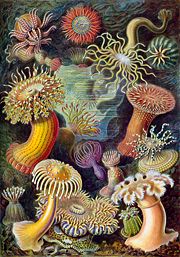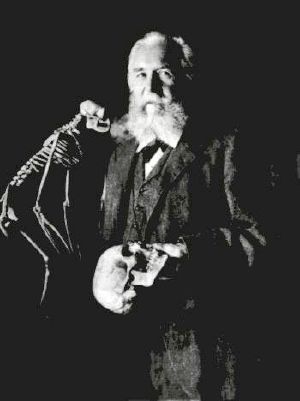Ernst Haeckel
Ernst Heinrich Philipp August Haeckel (February 16, 1834 — August 8, 1919), also written von Haeckel, was an eminent German biologist and philosopher. He promoted Charles Darwin's work in Germany and developed the theory that the organisms' biological development, or ontogeny, parallels its species' evolutionary development, or phylogeny.
Research
Haeckel was a zoologist, an accomplished artist and illustrator, and later a professor of comparative anatomy. He was one of the first to consider psychology as a branch of physiology. He also proposed many now ubiquitous terms including "phylum" and "ecology." His chief interests lay in evolution and life development processes in general, including development of nonrandom form, which culminated in the beautifully illustrated Kunstformen der Natur (Art forms of nature).
Haeckel advanced the "recapitulation theory" which proposed a link between ontogeny (development of form) and phylogeny (evolutionary descent), summed up in the phrase "ontogeny recapitulates phylogeny". He supported the theory with embryo drawings that have since been shown to be oversimplified and in part inaccurate, and the theory is now considered an oversimplification of quite complicated relationships. It is thought that Heackel deliberately faked the images to get more support for his ideas. Haeckel introduced the concept of "heterochrony", which is the change in timing of embryonic development over the course of evolution.
Haeckel was also known for his "biogenic theory", in which he suggested that the development of races paralleled the development of individuals. He advocated the idea that "primitive" races were in their infancies and needed the "supervision" and "protection" of more "mature" societies.
He extrapolated a new religion or philosophy called Monism from evolutionary science. In Monism, which postulates that all aspects of the world form an essential unity, all economics, politics, and ethics are reduced to "applied biology". His writings and lectures on Monism were later used to provide scientific (or quasi-scientific) justifications for racism, nationalism, and social Darwinism[citation needed].
Biography

Haeckel studied under Carl Gegenbauer in Jena for three years before becoming a professor of comparative anatomy in 1862. Between 1859 and 1866, he worked on many "invertebrate" groups, including radiolarians, poriferans (sponges) and annelids (segmented worms). He named nearly 150 new species of radiolarians during a trip to the Mediterranean. "Invertebrates" provided the fodder for most of his experimental work on development, leading to his "law of recapitulation". Haeckel was also a free-thinker who went beyond biology, dabbling in anthropology, psychology, and cosmology. Haeckel's speculative ideas and apparent fudging of data, plus lack of empirical support for many of his ideas, tarnished his scientific credentials. However, he remained an immensely popular figure in Germany and was considered a hero by his countrymen.
Haeckel was a flamboyant figure. He sometimes took great (and non-scientific) leaps from available evidence. For example, at the time that Darwin first published On the Origin of Species by Means of Natural Selection, no remains of human ancestors had yet been found. Haeckel postulated that evidence of human evolution would be found in the Dutch East Indies (now Indonesia), and described these theoretical remains in great detail. He even named the as-of-yet unfound species, Pithecanthropus alalus, and charged his students to go find it. (Richard and Oskar Hertwig were two of Haeckel´s many important students.)
Remarkably, one student did so: a young Dutchman named Eugene Dubois went to the East Indies and dug up the remains of Java Man, the first human ancestral remains ever found. (These remains originally carried Haeckel's Pithecanthropus label, though they were later reclassified as Homo erectus.)
Although Haeckel's ideas are important to the history of evolutionary theory, and he was a competent invertebrate anatomist most famous for his work on radiolaria, many speculative concepts that he championed are now considered incorrect. For example, Haeckel described and named hypothetical ancestral microorganisms that have never been found. His concept of recapitulation has been disputed in the form he gave it (now called "strong recapitulation"). Haeckel did not support natural selection, rather believing in a Lamarckian inheritance of acquired characteristics (Darwin considered both of these paths for evolution viable)[1].
Ernst Haeckel, much like Herbert Spencer, was always quotable, even when wrong. Although best known for the famous statement "ontogeny recapitulates phylogeny", he also coined many words commonly used by biologists today, such as phylum, phylogeny, and ecology. On the other hand, Haeckel also stated that "politics is applied biology", a quote used by Nazi propagandists. The Nazi party, rather unfortunately, used not only Haeckel's quotes, but also Haeckel's justifications for racism, nationalism and social Darwinism.
Mount Haeckel is a 4090 m (13,418') summit in the Eastern Sierra Nevada, overlooking the Evolution Basin, named in honor of Ernst Haeckel as is the asteroid 12323 Häckel.
Notes
- ↑ Ruse, M. 1979. The Darwinian Revolution. Chicago: University of Chicago Press
ReferencesISBN links support NWE through referral fees
- Richard Milner, The Encyclopedia of Evolution: Humanity's Search for Its Origins, Henry Holt, 1993
Further reading
- Art Forms from the Ocean: The Radiolarian Atlas of 1862, by Ernst Haeckel, Prestel Verlag, 2005 ISBN 3791333275
- Works by Ernst Haeckel. Project Gutenberg
External links
- Marine Biological Laboratory Library - An exhibition of material on Haeckel, including background on many Kunsformen der Natur plates
- University of California, Berkeley - Ernst Haeckel biography
- Ernst Haeckel – Evolution's controversial artist. A slide-show essay about Ernst Haeckel.
- Kunstformen der Natur, Wikimedia Commons.
- Kunstformen der Natur, scanned (from biolib.de Stuebers Online Library)
- PNG alpha-transparencies of Haeckel's "Kustformen der natur"
- Proteus - An animated documentary film on the life and work of Ernst Haeckel
See also
- Embryo drawings
Credits
New World Encyclopedia writers and editors rewrote and completed the Wikipedia article in accordance with New World Encyclopedia standards. This article abides by terms of the Creative Commons CC-by-sa 3.0 License (CC-by-sa), which may be used and disseminated with proper attribution. Credit is due under the terms of this license that can reference both the New World Encyclopedia contributors and the selfless volunteer contributors of the Wikimedia Foundation. To cite this article click here for a list of acceptable citing formats.The history of earlier contributions by wikipedians is accessible to researchers here:
The history of this article since it was imported to New World Encyclopedia:
Note: Some restrictions may apply to use of individual images which are separately licensed.

